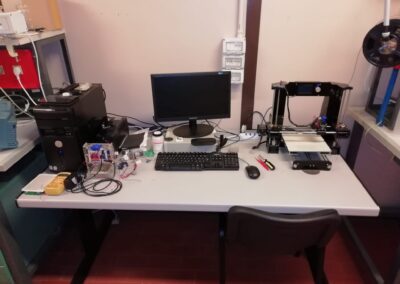The laboratory was spatially designed according to the current concept of design and prototyping of polluting monitoring systems. In fact, it is divided into three sections plus one dedicated to the research / commercial activity for the development of ad-hoc Quartz Crystal Microbalance (QCM) sensors:
- PC workstation with software dedicated to the programming of microcontrollers (eg Arduino, ESP32, Raspberry PI, FPGA ACTEL,…) and to the simulation of analog / digital interface circuits for the control and signal-handling of sensor systems for monitoring.
- Electronic test bench and welding; where the first prototypes of sensor control boards, interfaces and prototyping bread-boards are built. The bench is equipped with measuring instruments to carry out tests and to power the circuits under development (eg 4-channel 400 MHz oscilloscope, 200MHz frequency counter, 1Hz-200 MHz arbitrary function generators, precision bench digital multimeter, low and low power supplies. high power with remote control from Labview, professional soldering station with fume extraction and tools of various kinds.
- Mechanical prototyping; 3D printer, control cutter, manual cutter, laser engraving system.
- Bench for assembly, deposition, functionalization and electrical test of QCM sensors. The bench has several equipment for controlling the fundamental parameters of the QCM sensor including: Network Analyzer 3 KHz - 1 GHz, impedance meter, soft contact station for electrodes.
INSTRUMENTS
INSTRUMENTATION: 3D printers (Anet A6 e)
PURPOSE PURPOSE: The use of the 3D printer allows the creation of specific pieces for the development and realization of prototypes, of customized sensor systems, to be used in different areas. The dimensions of the printer plates allow the creation of pieces up to dimensions of 22cm x 22cm base and 25cm in height. Various filaments can be used, of different materials (such as ABS, PLA, PP, etc.), depending on the object to be made.
Contact person: Emiliano Zampetti
INSTRUMENTATION: Development of prototypes for environmental monitoring systems
Examples of indoor-outdoor environmental monitoring systems on bench or mobile platforms entirely developed home-made and based on different operating principles
Contact person: Emiliano Zampetti









